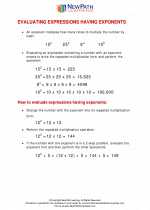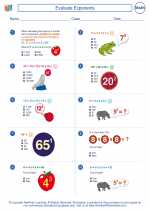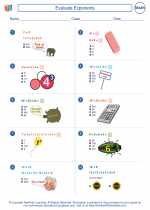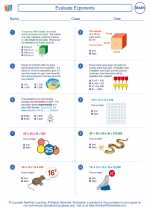Evaluating Exponents
An exponent represents the number of times a base number is multiplied by itself. It is denoted by a superscript number placed to the right and slightly above the base number. For example, in the expression 34, 3 is the base and 4 is the exponent. This means that 3 is multiplied by itself 4 times.
Basic Exponent Rules
When evaluating exponents, there are some basic rules to keep in mind:
- Product of Powers: When multiplying two numbers with the same base, you can add the exponents. For example, 32 * 34 = 36.
- Quotient of Powers: When dividing two numbers with the same base, you can subtract the exponents. For example, 65 / 63 = 62.
- Power of a Power: When a number is raised to an exponent and then raised to another exponent, you can multiply the exponents. For example, (23)4 = 212.
- Zero Exponent: Any non-zero number raised to the power of 0 is equal to 1. For example, 50 = 1.
- Negative Exponent: A negative exponent indicates the reciprocal of the base raised to the positive exponent. For example, 4-2 = 1 / 42 = 1 / 16.
Examples of Evaluating Exponents
Let's go through some examples to demonstrate how to evaluate exponents using the rules mentioned above:
- Evaluate 23 * 25:
- Evaluate 94 / 92:
- Evaluate (52)3:
- Evaluate 70:
- Evaluate 8-2:
Using the product of powers rule, we add the exponents: 23 * 25 = 28.
Using the quotient of powers rule, we subtract the exponents: 94 / 92 = 92.
Using the power of a power rule, we multiply the exponents: (52)3 = 56.
As per the zero exponent rule, any non-zero number raised to the power of 0 is equal to 1: 70 = 1.
Using the negative exponent rule, we take the reciprocal of the base raised to the positive exponent: 8-2 = 1 / 82 = 1 / 64.
Practice Problems
Now, let's try some practice problems to reinforce the concepts:
- Evaluate 43 * 42.
- Evaluate 105 / 103.
- Evaluate (64)2.
- Evaluate 20.
- Evaluate 3-3.
After solving these practice problems, you should have a better understanding of how to evaluate exponents using the rules and examples provided above.
.◂Math Worksheets and Study Guides Sixth Grade. Evaluate Exponents

 Worksheet/Answer key
Worksheet/Answer key
 Worksheet/Answer key
Worksheet/Answer key
 Worksheet/Answer key
Worksheet/Answer key
